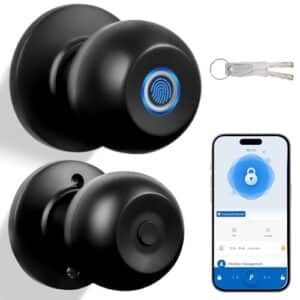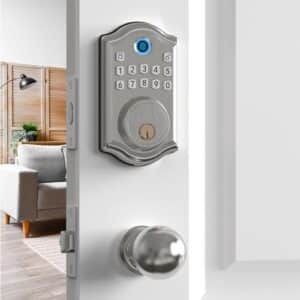How to Lock a Smart Lock Door: Best Practices for Security
Key Takeaways
- Choose a reputable smart lock brand to ensure security.
- Enable two-factor authentication for an extra layer of security.
- Keep your smart lock’s firmware up to date to address any vulnerabilities.
Smart locks offer convenience and enhanced security for your home, but it’s crucial to ensure that you are locking your smart lock door properly. In this article, we will explore the best practices for locking a smart lock door, providing you with the necessary information to keep your home safe and secure.
Choose a Reputable Smart Lock
When it comes to securing your smart lock door, the first step is to choose a reputable smart lock brand. Look for smart locks from trusted manufacturers that have a solid reputation for security. This will give you peace of mind knowing that your lock has undergone rigorous testing and meets industry standards.
Some popular smart lock brands include Schlage, August, Yale, and Kwikset. These brands offer a range of smart locks with different features and security levels, allowing you to find the one that best suits your needs.
Enable Two-Factor Authentication
Two-factor authentication adds an extra layer of security to your smart lock system. Many smart lock systems offer this feature, which requires a second form of verification in addition to your regular password. This could be a fingerprint scan, a code sent to your phone, or a voice command.
By enabling two-factor authentication, you significantly reduce the risk of unauthorized access to your smart lock door. Even if someone manages to obtain your password, they would still need the second form of verification to gain entry.
Keep Firmware Up to Date
Regularly updating your smart lock’s firmware is essential for maintaining its security. Firmware updates often include security patches and bug fixes that address any vulnerabilities in the system. By keeping your smart lock’s firmware up to date, you ensure that you have the latest protections against potential threats.
Check the manufacturer’s website or the accompanying app for firmware updates. Follow the instructions provided to install the updates and ensure that your smart lock is always running the latest version of its software.
Use Strong and Unique Passwords
Setting a strong and unique password for your smart lock system is crucial for protecting against unauthorized access. Avoid using common or easily guessable passwords, such as your birthdate or “123456.” Instead, create a password that combines a mix of uppercase and lowercase letters, numbers, and special characters.
Using a password manager can help you generate and store strong passwords securely. This way, you don’t have to rely on your memory to remember complex passwords for all your devices and accounts.
Secure Your Network
Your smart lock relies on a stable and secure Wi-Fi network for communication. Ensure that your Wi-Fi network is protected by using a strong password and encryption. Avoid using default passwords provided by your internet service provider (ISP) and choose a unique password that is difficult to guess.
Consider setting up a separate network for your smart devices to isolate them from your main network. This can provide an added layer of security and prevent any potential breaches from affecting your other devices.
Disable Unnecessary Features
Some smart locks come with additional features that you may not need or use. It’s a good practice to disable any unnecessary features to minimize potential security vulnerabilities. These features could include remote access from outside your home, voice control, or integration with third-party apps.
By disabling these features, you reduce the attack surface and limit the potential for unauthorized access to your smart lock door.
Monitor Access and Activity
Take advantage of the activity logs and notifications provided by your smart lock system to monitor who is entering or leaving your home. This can help you identify any suspicious activity and take appropriate action.
Set up notifications to receive alerts whenever the smart lock is engaged or disengaged. This way, you can stay informed about the comings and goings at your home, even when you are not there.
Follow Manufacturer’s Instructions
It’s important to follow the manufacturer’s instructions when installing and setting up your smart lock. Each smart lock may have its own specific installation process, so refer to the provided user manual or installation guide for the most accurate and up-to-date information.
If you are unsure about installing the smart lock yourself, consider hiring a professional locksmith. They have the expertise and experience to ensure that the lock is installed correctly and securely.
Conclusion
Locking a smart lock door properly is essential for maintaining the security of your home. By following these best practices, such as choosing a reputable smart lock, enabling two-factor authentication, keeping firmware up to date, using strong passwords, securing your network, and monitoring access and activity, you can enhance the security of your smart lock door.
Remember to always refer to the manufacturer’s instructions for specific details and recommendations regarding your smart lock model.
Related Websites:
- How to Choose and Install a Smart Lock According to a Smart Security Expert – T3
- Smart Lock Safety and Security – Schlage
- The Best Smart Lock – The New York Times
- Best Smart Locks for 2021 – CNET
- The Best Smart Door Locks for 2021 – The Verge
- How to Use Your Smart Lock Safely – CNET
- How to Lock or Unlock Smart Locks: A Comprehensive Guide – ElemaKe Locks
FAQs:
Q: What is a smart lock door?
A smart lock door is a keyless entry system that allows you to lock and unlock your door using a smartphone app, keypad, or physical key.
Q: What are the benefits of smart lock doors?
Smart lock doors offer convenience, improved security, and flexibility. They allow you to remotely control access, monitor activity, and provide temporary access to guests.
Q: How do I lock a smart lock door using a smartphone app?
To lock a smart lock door using a smartphone app, open the app, select the lock option, and confirm the action. Some apps also provide additional security features like fingerprint or face recognition.
Q: What are the best practices for securing a smart lock door?
To secure a smart lock door effectively, ensure you have a strong and unique password, regularly update firmware and app versions, and limit access permissions to trusted individuals. It’s also recommended to enable two-factor authentication if available.
Q: How can I troubleshoot common locking issues with a smart lock door?
If you encounter common locking issues with a smart lock door, try the following troubleshooting steps: ensure the door is properly aligned, replace batteries if needed, check connectivity between the lock and the app, and contact customer support if problems persist.






